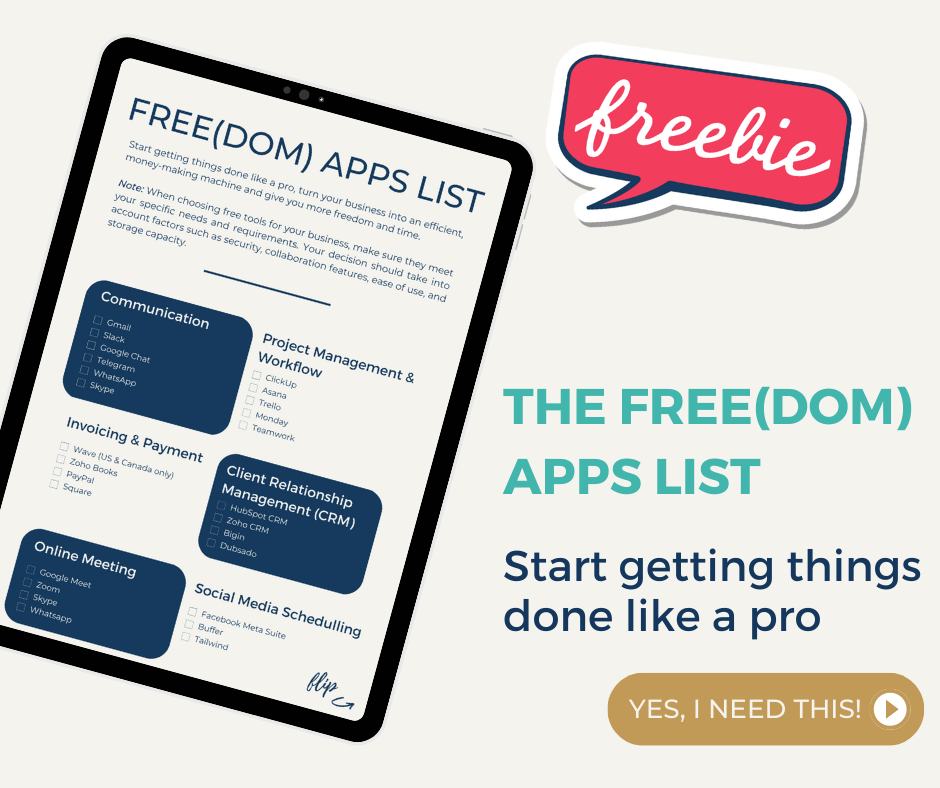“Innovation is the outcome of a habit, not a random act.”
Sukant Ratnakar, author
Running an online business requires a strategic approach to technology, innovation and growth.
But with so many tech tools available, selecting the right ones for your specific business needs can be overwhelming.
You might find yourself stuck between opting for budget-friendly software that lacks essential features that you need, or investing in high-end tools that you hardly use.
I often find one of these two scenarios is the case for all the business owners I work with.
Here’s a guide to help you navigate the tech tools choices so you can build an effective tech stack for your business.
What are tech tools and what’s a tech stack?
- Tech tools: These tools range from project management software and customer relationship management (CRM) systems to marketing automation platforms and accounting software. Each tool serves a specific function, making it easier for business owners to handle their day-to-day tasks and long-term strategies.
- Tech stack: The combination of these tools mentioned above that you use to run your business. Think of it as the collection of software and technologies that form the backbone of your business processes. Your tech stack should be designed to meet your specific business needs, ensuring all the tools you use integrate seamlessly and work together to support your business goals.
As a side note: A well-defined tech stack matters.
- Efficiency: A well-integrated tech stack ensures that your tools work together seamlessly, reducing manual tasks and improving efficiency.
- Scalability: As your business grows, a scalable tech stack can accommodate increased demand without major tech overhauls.
- Cost-effectiveness: By carefully selecting tools that meet your specific needs, you avoid wasting money on unnecessary features.
- Data management: A cohesive tech stack allows for better data management and analytics, helping you make more informed business decisions.
- Enhanced collaboration: Integrated tools improve communication and collaboration across your team, creating a more productive work environment.
Why are tech tools important?
Tech tools streamline your operations, making your business more efficient and productive.
The right tools can save you time, reduce errors, and help you manage tasks more effectively. They are essential for scaling your business and staying competitive.
Here’s how to choose the best tech tools for you: 3 top tips
1. Understand your requirements and needs
Before you start looking for (and buying or subscribing to) tech tools, list down the tasks and processes that are essential for your business. Sketch out your workflow and have a look at the tasks that need automation or support from software.
2. Consider future growth
Think about where you want your business to be in the next 3-5 years. Choose tools that can scale with your business as it grows. You don’t want to switch software frequently because it can’t handle your growth.
3. Evaluate your learning time
Consider how easy it is to learn and use the software. Are you willing to invest time in learning it, or do you need a dedicated team member, like an OMB, to manage it? If you need to hire someone, factor in the additional costs.
My real-life story: Ee Zen Cha, Online Business Manager (OBM)
After trying various top-rated and budget-friendly tech tools, I realised that the most recommended or “best” software didn’t always meet my needs – even if the top business people were using them.
So I began by listing the specific tasks I needed help with and mapping out my processes looking at each step. This helped me identify the features I personally needed in a tech tool for my business – and that’s where you will see what you actually need, not what you are told you need.
By focusing on my actual needs, I found tools that fitted perfectly.
I also considered my business’s future growth too, ensuring that the software I chose could scale with my business.
If you have a big plan to scale your business, then the software you pick should have the ability to handle the growth. You want to avoid regularly changing software because it has either reached its capacity or you are just not fully utilising its features.
You will end up paying big dollars with monthly subscription fees.
The tech tools I use in my business
By choosing the right tech tools, you can free yourself from the chaos of daily operations and fully step into your role as a visionary leader.
Here’s a look at the tech stack I use to run my operations effectively:
Google Workspace
- Gmail: Email management
- Google Meet: Video meetings
- Google Calendar: Appointments
- Google Drive: Storage and file collaboration
- Google Docs, Sheets and Slides: Document creation and collaboration
ClickUp
- Project management: Organise and track projects
- Task management: Manage my tasks and my team’s tasks
- SOP vault: Store standard operating procedures
- CRM: Manage customer relationships
Xero
- Invoices: Billing clients
- Quotes: Providing estimates
- Budget: Financial planning
- Forecast: Predicting future revenue
Canva
- Visual graphics: Creating marketing material
MailerLite
- Email marketing platform: Managing email campaigns
WordPress
- CMS: Content management for my website
Slack
- Communication: Team messaging
Berrycast
- Screen recording: Creating instructional videos
Ready to scale up your tech stack?
Choosing the right tech tools can transform your business’s operations, making it more efficient and allowing you to focus on your big vision.
To help you get started, I’ve created a comprehensive list of the apps for online businesses.
It’s your first step to organising and scaling up your business operations.
Download my free app list below.






